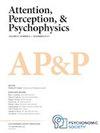Skills and cautiousness predict performance in difficult search
Abstract
People differ in how well they search. What are the factors that might contribute to this variability? We tested the contribution of two cognitive abilities: visual working memory (VWM) capacity and object recognition ability. Participants completed three tasks: a difficult inefficient visual search task, where they searched for a target letter T among skewed L distractors; a VWM task, where they memorized a color array and then identified whether a probed color belonged to the previous array; and the Novel Object Memory Test (NOMT), where they learnt complex novel objects and then identified them amongst objects that closely resembled them. Exploratory and confirmatory factor analyses revealed that there are two latent factors that explain the shared variance among these three tasks: a factor indicative of the level of caution participants exercised during the challenging visual search task, and a factor representing their visual cognitive abilities. People who score high on the search cautiousness tend to perform a more accurate but slower search. People who score high on the visual cognitive ability factor tend to have a higher VWM capacity, a better object recognition ability, and a faster search speed. The results reflect two points: (1) Visual search tasks share components with visual working memory and object recognition tasks. (2) Search performance is influenced not only by the search display’s properties but also by individual predispositions such as caution and general visual abilities. This study introduces new factors for consideration when interpreting variations in visual search behaviors.


 求助内容:
求助内容: 应助结果提醒方式:
应助结果提醒方式:


